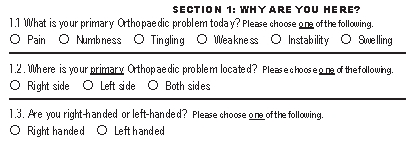|
|
||||
|
|
||||
Optical Mark reading (OMR) is a method of entering data into a computer system. Optical Mark
Readers reads pencil or pen marks made in pre-defined positions on paper forms as responses to
questions or tick list prompts. The OMR data entry system contains the information to convert the
presence or absence of marks into a computer data file.
The OMR technology could be used if data is to be collected from a large number of sources
simultaneously, a large volume of data must be collected and processed in a short period of time,
information mainly comprises the selection of categories or "tick box" answers to multiple- choice
questions.
Example of OMR based questionnaire form
 The main advantages of OMR technology are as follows:
OMR scanning is fast: An OMR scanner can maintain a throughput of 2000 to 10,000 forms per
hour. This activity can be controlled and processed by a single PC workstation, which can handle
any volume the scanner can generate. Increasing the throughput simply requires upgrading the
scanner. Double entry is not required.
OMR scanning is accurate: It consistently provides unmatched accuracy when reading data,
exceeding the accuracy of expert key-entry clerks because it eliminates transcription errors.
OMR scanning is cost effective: With OMR technology, organizations can accomplish a wide
variety of administrative tasks rapidly and accurately from a central location, with minimum initial
and ongoing outlay of funds.
OMR scanning is easy to implement and support : Compared to many PC network installations,
OMR scanners' need for ongoing technical support is minimal. OMR scanners also solve most
system availability issues: data can be recorded on an OMR form even when a PC or network goes
down. If questions arise, a source form is available to validate results.
|
||||